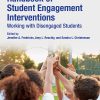For decades, educators everywhere have been searching for ways to reach both students who are chronically absent and those who are present but only half-heartedly engaged in learning. These problems are particularly devastating in high-poverty urban communities where graduation or dropping out can be the dividing line between a middle-class life or one of continued poverty. The search for solutions has led to the development of multipronged school reform models that better engage students in learning and help keep them in school through graduation.
In a newly published chapter, called “Effective school reforms for increasing engagement,” in the textbook Handbook of Student Engagement Interventions: Working with Disengaged Students, published May 17, 2019, two researchers at the Johns Hopkins University School of Education survey five top reform models that have been proven effective at keeping students in school as engaged learners.
“It’s increasingly apparent that if you want deep learning, you need deep student engagement,” said Douglas Mac Iver, who co-authored the chapter with colleague and teaching professional Tristan Hann. “Our chapter looks at five achievable, scalable, and successful models certain school districts around the country have used to increase engagement in middle- and high-school grades.”
Mac Iver is a member of Johns Hopkins newly formed Center for Safe and Healthy Schools, a multidisciplinary effort to bring evidence-based practices to bear to make schools safer and healthier.
The researchers say all five models have been demonstrated to be effective through rigorous studies and to be doable and scalable across a variety of different schools or districts.
The five models are:
- Diplomas Now – A model used in 50 middle and high schools in high-poverty urban communities nationwide that helps teachers improve their skills, combined with efforts to prevent students from developing the early-warning signs of dropping out—poor attendance, disruptive behavior, or failing grades.
- Student Success Mentors Initiative – A New York City program providing each “chronic absentee” a mentor for an entire academic year to productively address attendance challenges, nurture a sense of belonging at school, and connect students to engaging learning opportunities.
- Project SUCCESS – A student-centered approach that eases the notoriously difficult transition from elementary to middle school through small diverse learning communities of sixth graders who spend half of each school day together receiving interdisciplinary instruction in four subjects from one teacher. Project SUCCESS is designed to foster stronger interpersonal relationships, increase social engagement, and reduce disparities in students’ achievement growth.
- Project- and Problem-Based Learning – Students focus on solving complex, real-world problems in small groups. Each student fills an essential role in the project team that cultivates an eagerness to learn while reinforcing the values of individuality, self-expression, sense of purpose, and personal choice.
- Wall-to-Wall College and Career Academies – High schools tailor higher-grade courses and small learning groups to closely link courses and learning communities to long-term student academic and career pathways that are matched to students’ personal preferences.
Mac Iver and Hann’s chapter is designed for educators, administrators, and policymakers who may think of pervasive disengagement as an intractable problem, but who remain hopeful that practical, achievable options still exist to combat the challenge.
Disengagement in school—combined with the enticements of more engaging activities outside of school—are major causes of absenteeism and low graduation rates among poor urban youth. One-third of the middle school students and one-half of high school students are chronically absent and graduation in these neighborhoods is a “distressingly low” 76 percent.
What is new in this chapter, Mac Iver said, is the review’s focus on reforms that involve whole departments, schools, or districts in coordinated, multifaceted efforts to increase engagement across all classrooms rather than traditional interventions for individual educators to use in reaching just the disengaged students in their own classrooms.
Too often, disengagement has been considered a teacher-by-teacher, classroom-by-classroom issue. This new chapter raises the responsibility for student engagement to the whole-school or even whole-district level. Engagement is everyone’s responsibility, the researchers stress—teachers, administrators, policymakers, and parents alike.
“The granular approach is an inefficient way to tackle the massive problem that is student engagement,” Mac Iver says. He prefers programs that enable the whole math or science departments to work together to make science and math instruction more engaging. Better yet, he says, is when entire grades, schools, and districts get behind such programs.
“Any comprehensive plan to improve engagement demands an integrated prevention and tiered intervention model,” the authors write in their chapter.
While such surveys of successful models are encouraging and valuable to school districts eager to counteract absenteeism and increase active engagement, Mac Iver cautions that they are a roadmap, not a panacea. One important step that is often overlooked in the urgency to implement such programs, he says, is the critical part consensus plays in program success.
“Unfortunately, many reforms tragically explode upon launch if there hasn’t been enough prior preparation and consensus building,” he says. “A big part of the reason why these five reforms were successful is they weren’t undertaken without the supports and professional development needed to make sure they succeed.”

